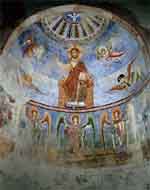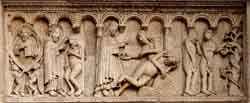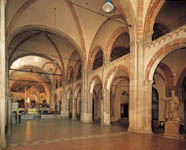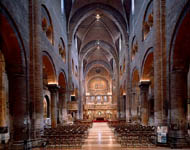Romanesque art
ll the artistic trends that developed in Europe between the year 1000 and the end of the XII century are generally referred to as ‘Romanesque’ because of the Roman influence that characterises the art of this period. Romanesque art differs from Roman art (which is more totalitarian) and the way it developed depended on the geographical regions. It reflects the different economic situation and cultural diversity of each individual town. After the year 1000, European towns started expanding in size. The number of inhabitants increased because of fewer barbarian invasions, general improvement of the economy and increased commercial activity. Therefore in this period there was considerable innovation which involved art as well.
In cities this process took place through the renovation of pre-existing Roman structures and through the building of new towns, based upon an elaboration of the Roman Castrum layout or by expanding monasteries and feudal castles.
Obviously all new cities had to be defended and models of towns surrounded by walls or isolated fortifications were planned.
Romanesque painting

Romanesque painting is stronglyconnected with the Byzantine and late-classical painting tradition which had survived the barbarian invasions during the centuries (unlike sculpture and architecture). Linked to local cultural and artistic traditions, Romanesque painting developed differently in the various parts of Italy. In Lombardy the fresco technique developed from the Carolingian and ottonian artistic tradition.
Examples of precious frescos in northern Italy are those in S. Vincenzo a Galliano and S. Pietro al Monte a Civate, still tied to the ottonian tradition, whereas the frescos in the Benedictine abbey of S. Angelo in Formis have Byzantine traits, as do the ones in S. Elia a Nepi, in Aquileia, in S. Maria di Castello in Udine, of Assisi in Sacro Speco and the Lower Church, in Anagni and S. Clemente in Rome.
Byzantine tradition favoured mosaics and examples can be seen in Venice and in Sicily (for example, the ones in St Mark’s Cathedral in Venice and in the cathedral of Cefalù, in the province of Palermo).
In Tuscany and in Umbria painting on wooden boards was the preferred technique and crucifixes became very important. Up to this moment crucifixion had always been shown in context and Christ on the cross was never ‘alone’; this new development started a new trend, which made the crucifix the symbol of Christianity.
All over Europe miniatures became incredibly popular. They were created by monks, who used to decorate their books in various ways (with animals, plants, geometric decorations, splendid decorated initials) while copying holy and secular texts for their great libraries
Romanesque sculpture
From the beginning of the year 1000 sculpture, like architecture, went through a process of rebirth and renewal. The repertoire was at first influenced by popular elements and elements from the late classical era but it developed in a new way. Architecture and sculpture were, at the beginning, closely related because sculpture was used to decorate architectural structures.

The facades of Romanesque cathedrals were richly decorated with scenes from the Old and New Testament. An example of stories from the book of Genesis is on the facade of the cathedral in Modena, carved by Wiligelmo around 1106.
Generally Romanesque sculpture gave volume to bodies and shapes, which during the Byzantine period had been rigidly stylised. These new characters are then set in a background which is similar to the real world.
There were many different themes, both religious and secular: stories from the Bible, from the Gospel and the book of Genesis, scenes from everyday life, fantastic monsters and geometric decorations. The monk Bernardo of Chiaravalle strongly opposed the use of monsters from hell which were supposed to frighten the faithful. The intent of the sculpture from this period was to transmit a moral and religious message which the general, mostly very ignorant, population, would otherwise have failed to understand.
Romanesque architecture
Even if Romanesque style architecture was born in France it rapidly expanded in Italy. In the various regions of Italy Romanesque style took on different characteristics, depending on the different economic conditions of each place, on its political organisation and, most importantly, on the availability of building materials. The typical features of this style can usually be found more or lesseverywhere. In churches and other religious buildings the most common plan was a basilica with a Latin cross, with three or five bays, using cross vaults to replace the wooden trusses which decayed more easily. A cross vault is a stonework vault with a square base, formed by the diagonal intersection of two arches with the same radius which form four ribs. The space beneath each cross vault is called a bay.
Most of the non-religious buildings from this period are fortified castles and towers which gave towns and cities the look they still have today (San Gimignano is an example).
Church of Sant'Ambrogio in Milan

Built between the XI and XII centuriesthe basilica of Sant'Ambrogio in Milan is a classicexample of Romanesque art in northern Italy. It is a rectangular-plan basilica with three naves. The middle nave is twice as wide as the side naves which are the base of the matroneum. There arefour bays in the central nave: three are covered by cross vaults with ribs and the fourth by a dome. A typical feature of this church are the so called ‘bundle pillars’. i.e. pillars formed by smaller pillars or columns on the axis or at the corner of the cross vaults.
Cathedral of Modena

The building of Modena’s cathedral began in1099 and ended only in the XIV century. It is a rectangular-plan church with three naves divided by eight bundle pillars and covered by cross vaults with ribs. The famous architect Lanfranco and the sculptor Wiligelmo worked on the building of this cathedral. The matroneum is on the side naves, like in the Church of Sant'Ambrogio, marked by three-mullioned windows but, unlike the Sant'Ambrogio matroneum, it cannot be entered. Three-mullioned windows can be seen in the church exterior. This was how the architect chose to connect the exterior of the church with the interior.
 Romanesque painting is stronglyconnected with the Byzantine and late-classical painting tradition which had survived the barbarian invasions during the centuries (unlike sculpture and architecture). Linked to local cultural and artistic traditions, Romanesque painting developed differently in the various parts of Italy. In Lombardy the fresco technique developed from the Carolingian and ottonian artistic tradition.
Romanesque painting is stronglyconnected with the Byzantine and late-classical painting tradition which had survived the barbarian invasions during the centuries (unlike sculpture and architecture). Linked to local cultural and artistic traditions, Romanesque painting developed differently in the various parts of Italy. In Lombardy the fresco technique developed from the Carolingian and ottonian artistic tradition.  The facades of Romanesque cathedrals were richly decorated with scenes from the Old and New Testament. An example of stories from the book of Genesis is on the facade of the cathedral in Modena, carved by Wiligelmo around 1106.
The facades of Romanesque cathedrals were richly decorated with scenes from the Old and New Testament. An example of stories from the book of Genesis is on the facade of the cathedral in Modena, carved by Wiligelmo around 1106. Built between the XI and XII centuriesthe basilica of Sant'Ambrogio in Milan is a classicexample of Romanesque art in northern Italy. It is a rectangular-plan basilica with three naves. The middle nave is twice as wide as the side naves which are the base of the matroneum. There arefour bays in the central nave: three are covered by cross vaults with ribs and the fourth by a dome. A typical feature of this church are the so called ‘bundle pillars’. i.e. pillars formed by smaller pillars or columns on the axis or at the corner of the cross vaults.
Built between the XI and XII centuriesthe basilica of Sant'Ambrogio in Milan is a classicexample of Romanesque art in northern Italy. It is a rectangular-plan basilica with three naves. The middle nave is twice as wide as the side naves which are the base of the matroneum. There arefour bays in the central nave: three are covered by cross vaults with ribs and the fourth by a dome. A typical feature of this church are the so called ‘bundle pillars’. i.e. pillars formed by smaller pillars or columns on the axis or at the corner of the cross vaults.  The building of Modena’s cathedral began in1099 and ended only in the XIV century. It is a rectangular-plan church with three naves divided by eight bundle pillars and covered by cross vaults with ribs. The famous architect Lanfranco and the sculptor Wiligelmo worked on the building of this cathedral. The matroneum is on the side naves, like in the Church of Sant'Ambrogio, marked by three-mullioned windows but, unlike the Sant'Ambrogio matroneum, it cannot be entered. Three-mullioned windows can be seen in the church exterior. This was how the architect chose to connect the exterior of the church with the interior.
The building of Modena’s cathedral began in1099 and ended only in the XIV century. It is a rectangular-plan church with three naves divided by eight bundle pillars and covered by cross vaults with ribs. The famous architect Lanfranco and the sculptor Wiligelmo worked on the building of this cathedral. The matroneum is on the side naves, like in the Church of Sant'Ambrogio, marked by three-mullioned windows but, unlike the Sant'Ambrogio matroneum, it cannot be entered. Three-mullioned windows can be seen in the church exterior. This was how the architect chose to connect the exterior of the church with the interior.